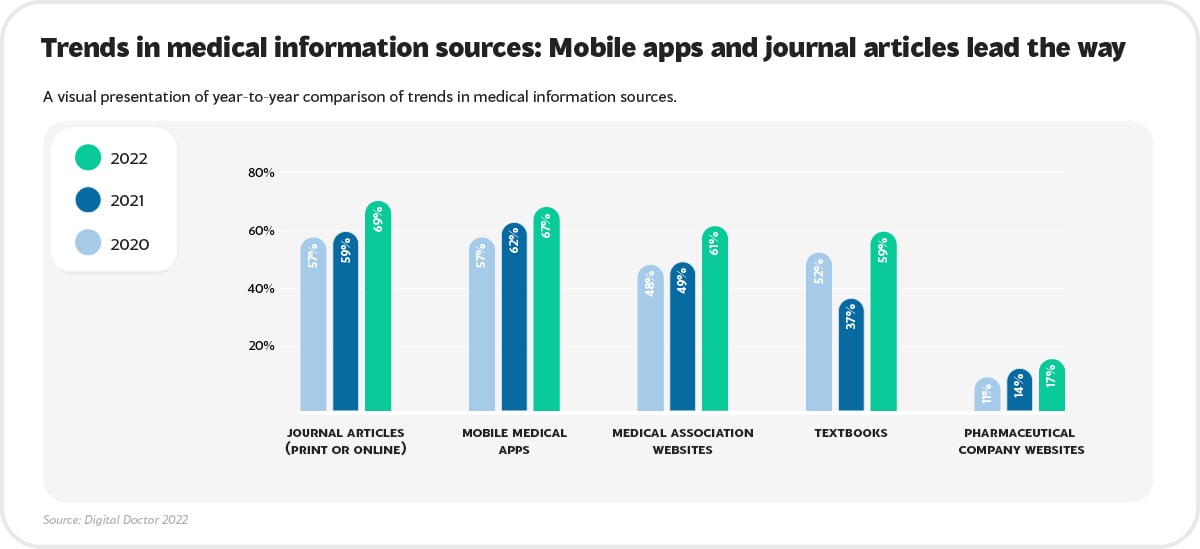Lessons learned in a decade of doctor digital pharma marketing in Europe
It’s been nearly 10 years since I sold my first ad spot to one of the biggest global pharmaceutical companies. Mediately was still a tiny startup, with 1,000 doctors using our app to get information on how to dose drugs and how to treat patients. To keep the app free and available to every doctor, we started selling advertising space.
That first sale felt incredible. It started our path to becoming one of the biggest medical apps in Europe, with 210,000 doctors using the Mediately app today. Along the way, we paved the way for digital marketing to doctors in Europe, and now we work with 27 of the top 30 global pharmaceutical companies – including that first client – helping them launch their products and educate doctors about new treatments.
Are we digital yet?
Digital pharma marketing has changed a lot in those 10 years. In the beginning, most of our client conversations were focused on the “why” – justifying why they should even think of digital channels at all. Doctors were already getting most of their information online, but in the eyes of pharma it was unproven, with compliance issues at every corner. Digital marketing at that time received less than 1% of their overall marketing budget, if any at all. Today, most conversations are focused on the “how” – figuring out how digital marketing can support their goals. The size of marketing budgets has slowly increased as well, though they are still well under 10% in the majority of cases. Although the pandemic quickly increased the size of digital budgets in 2020 and 2021, they quite surprisingly went back to pre-pandemic levels in the last year. All in all, it has been a gradual move towards making digital marketing a part of every marketing strategy; however, we are still a long way from it becoming a significant driver of these strategies.
In that same ten-year timeframe, the habits of doctors have changed significantly. They now get the vast of majority of their information online, from independent sources, and primarily through apps, as shown by our Digital Doctor survey, the biggest doctor survey in Europe, and confirmed by industry reports. And this isn’t a shift caused by the pandemic, it is a trend that’s consistent and strong, moving in one direction for the past ten years. Digital channels and tools offer doctors speed and flexibility in accessing the latest medical information, and it’s an unstoppable wave, the same as in every other industry.

So, if doctors spend 80-90% of their time and attention online, why is the digital marketing budget so slow to follow? Why are digital channels frequently still an afterthought when planning digital pharma marketing campaigns?
No matter how powerful the digital trend is among doctors, the core competencies of stakeholders involved in pharma marketing are largely not in digital channels, making that change tough to capitalize on. And this is not an insult to people in those roles – it is a skill that wasn’t needed before. A lot of our work has been in bridging that knowledge gap, and figuring out the concerns that exist on the pharma side.
It all boils down to overcomplicating digital pharma marketing, difficult compliance processes and a lack of a return-on-investment data.
Multichannel! No, no, omnichannel! Ooh, AI! Wait, where am I?
The marketing and consulting world is extremely good at coming up with buzzwords, acronyms and thrilling trends, bombarding the pharma industry with omnichannel this, AI that, making it feel like the world of digital pharma marketing is so complex, so rapidly changing that it’s basically impossible to keep up with, and one that requires constant revolutions in strategy to not fall behind (sidenote: we created a helpful digital marketing glossary for those who want to get simple explanations of marketing terms). All the while, most of the industry is still stuck printing paper brochures to hand out to doctors, because compliance processes haven’t kept up.
Now, sometimes all that excitement and buzzwordy innovation gets absorbed, squeezed through a few layers of bureaucracy, and pharma companies end up with an omnichannel pharma marketing strategy that takes that same paper brochure, puts it in a PDF, sends it to their email list in an email which doctors don’t open or engage with, and calls it a day – omnichannel success achieved, right? Some companies may go the extra mile, and put the PDF on an iPad, so the sales reps can scroll through it in front of the doctor during a visit – it’s even possible to track how many pages the doctor read together with the rep! A 360-degree view of the doctor’s journey of learning about our drug! Or a 360-degree view of the sales rep scrolling through the brochure in their car in the parking area of the hospital, because the doctor doesn’t have time to see them – depends on who you ask. If a pharma company is feeling extra bold and digital, they might even spend a few million dollars building an expensive website for healthcare professionals, put all those PDFs on it, and lock it behind a registration process that no doctor ever completes.
I am exaggerating, but much less than you can imagine. In all that hype and strategizing, the entire reason for involving digital marketing often gets lost. The job of digital pharma marketing is simple – get key messages to doctors on digital channels. They already use digital channels, apps, websites, newsletters, so why not use them? And the key messages already exist, they’re on that paper brochure and in that sales rep’s iPad presentation. The job absolutely isn’t to build your own digital channel, spending huge amounts of time and money to scream into an empty room. Reframed this way, the task of integrating digital pharma marketing becomes much simpler and more effective as well.
The job of digital pharma marketing is simple – get key messages to doctors on digital channels. They already use digital channels, apps, websites, newsletters, so why not use them?
Are you already approved as our vendor? Sorry, then we can’t work with you.
There is another objective reason that digital marketing often gets sidetracked in pharma, or pushed to ineffective internal platforms with no reach. The vast majority of online resources that doctors use are independent platforms. Which means third parties. Which means compliance processes, vendor approvals, custom contracts, and lots of headaches for anyone in pharma who wants to work with these third parties. Starting a new project with a new vendor is extremely complex in organizations the size of pharma companies. Often, just this mountain of tasks is enough to dissuade nearly everyone from going down that path. Companies often choose to carry out the campaign with internal resources, or work with a global vendor that might be completely ineffective – but has already been approved.
As newcomers 10 years ago, we came up against this obstacle repeatedly. We were obviously not approved as a vendor anywhere, and we were offering digital marketing solutions that the vast majority of clients had no compliance experience with. Much as I would love to give some smart advice here, the reality is that those compliance rules exist for a reason, drug advertising in Europe is heavily regulated and there is real risk if these processes aren’t taken care of. Yes, these processes could be done much better. There is also a real opportunity for a pharma company to outperform the rest of the market by learning to work with third party platforms at scale, enabling fast and effective digital marketing project delivery. Still, the reality is, it’s a necessary and needed component.
As a vendor, streamlining that process and helping pharma companies as much as possible in going through it is the only recipe for success. As a pharma company, those who are willing to push through end up with a really grateful partner on the other side and actually get real results for their digital marketing efforts.
What’s the ROI on this?
Last but not least, probably the biggest challenge is the lack of measurable return on investment in digital pharma marketing efforts. Very few pharma companies have a working model of how reaching doctors with their digital marketing efforts will influence sales, i.e. prescriptions of a specific drug. Separating the influence of digital marketing from sales and other marketing is incredibly difficult. Did a doctor prescribe a drug because they saw the news of a new study showing better outcomes compared to a competitor on their favourite medical app? Or because a sales rep knocked on their door and talked their ear off about how great this particular drug is? Or because the live event presenting the drug was really good?
There isn’t a typical online buyer journey where a doctor clicks “Prescribe” at the end, and digital marketers clap behind their screens as the “Revenue” counter goes up. The actual buyer journey is a lot more complicated and a lot more disconnected between different steps, making it difficult to measure the actual impact of this or that channel. Each internal stakeholder will naturally claim it’s because of their efforts. Digital marketing usually has the least resources, the lowest budget, and the least power at the table in these discussions (even more so if it’s done by an external partner), with sales and traditional marketing dominating. So even if a digital campaign is really successful in terms of reach and engagement, it rarely gets any credit for impacting sales.

Now this may sound like a typical excuse of a vendor that can’t prove it’s worth. The most illuminating case for us happened many years ago, when we had a unicorn case to prove the value of digital marketing. A pharma client wanted to promote an old drug. It was still a great drug for a specific disease, but as a product in “maintenance mode” with established, slowly declining sales, it had no marketing budget, no sales reps working on it and no plans on any marketing activity. The product manager said they wanted to try and see what happens if they run a reminder digital campaign, just getting the brand in front of the thousands of doctors in our app for a month. After more than a year of steadily declining sales, the month with our campaign saw a significant increase in sales – much to the surprise of the product manager. The ROI was better than anything else they had done on that product, by a wide margin. It was one of those rare moments of validation for us, and when discussing ROI, is one of my favourite stories to tell.
That’s not to say digital marketing is the holy grail for driving sales. It is an accelerator, an amplifier, making sure the key messages get heard, repeatedly. Will it have an ROI? If the key messages are meaningful and convincing to doctors, the answer is simply yes.
Keeping it simple
After hundreds of conversations with pharma clients through the years, there’s one thing I’m sure of. The task of developing new drugs, launching them in markets across the world, and figuring out how to get them in the hands of patients who need them is about a million times more difficult than digital marketing.
Proving the drug’s effectiveness in clinical studies, figuring out how to safely prescribe it, making sure it is reimbursed by insurance for patients – these are the tough challenges. Once those challenges are solved, involving digital marketing effectively is extremely simple. Find the biggest platform to reach doctors (or multiple platforms) and get the key messages about your product through to them. Tell them about the key study, raise awareness about the disease it treats, shout about the new reimbursement status.
Yes, you can go a lot deeper with your digital marketing strategy, there’s a million possibilities beyond those mentioned above. But that starting point is more than enough to drive meaningful results. So, start there, forget about the hype and focus on the basics.

